
Pomacentridae is a family of ray-finned fish, comprising the damselfishes and clownfishes. This family were formerly placed in the order Perciformes but are now regarded as being incertae sedis in the subseries Ovalentaria in the clade Percomorpha. They are primarily marine, while a few species inhabit freshwater and brackish environments. They are noted for their hardy constitutions and territoriality. Many are brightly colored, so they are popular in aquaria.
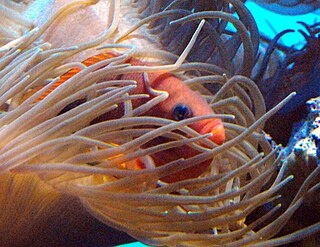
Amphiprion is a genus of ray-finned fish which comprises all but one of the species of clownfish or anemonefish in the subfamily Amphiprioninae of the family Pomacentridae.

Premnas biaculeatus, commonly known as spine-cheeked anemonefish or the maroon clownfish, is a species of anemonefish found in the Indo-Pacific from western Indonesia to Taiwan and the Great Barrier Reef. They can grow up to be about 17 cm (6.7 in). Like all anemonefishes it forms a symbiotic mutualism with sea anemones and is unaffected by the stinging tentacles of the host anemone. It is a sequential hermaphrodite with a strict size-based dominance hierarchy; the female is largest, the breeding male is second largest, and the male nonbreeders get progressively smaller as the hierarchy descends. They exhibit protandry, meaning the breeding male changes to female if the sole breeding female dies, with the largest nonbreeder becoming the breeding male. The fish's natural diet includes algae and zooplankton.

Bubble-tip anemone is a species of sea anemone in the family Actiniidae. Like several anemone species, E. quadricolor can support several anemonefish species, and displays two growth types based on where they live in the water column, one of which gives it the common name, due to the bulbous tips on its tentacles.
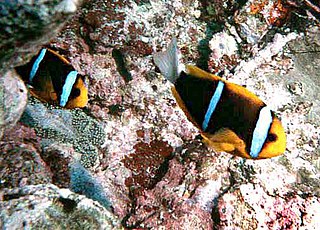
The orange-fin anemonefish is a marine fish belonging to the family Pomacentridae, the clownfishes and damselfishes, found in the Western Pacific north of the Great Barrier Reef from the surface to 20 m, to include the Pacific Ocean between Queensland, Australia, and New Guinea to the Marshall and Tuamotus Islands. It can grow to 17 cm in length.

Abudefduf also known as the sergeant-majors is a genus of fish in the family Pomacentridae.

The nosestripe clownfish or nosestripe anemonefish, skunk clownfish, Amphiprion akallopisos, is an anemonefish that lives in association with sea anemones. A. akallopisos is found in the Indian Ocean. It resides in shallow inshore reefs as deep as 15 m with a moderate to strong current. The skunk clownfish can also be kept in captivity by aquarists.

The leopard coral grouper, also known as the common coral trout, leopard coral trout, blue-dotted coral grouper or spotted coral grouper, is a species of marine ray-finned fish, a grouper from the subfamily Epinephelinae which is part of the family Serranidae, which also includes the anthias and sea basses. It is found in the Western Pacific Ocean.

Chromis iomelas, also known as the Half and Half Chromis, is a species of reef dwelling fish in the family Pomacentridae. It is occasionally seen for sale in the aquarium trade.

The Barrier Reef chromis, also known as the yellowback puller or shining puller, is a species of damselfish in the family Pomacentridae native to the east coast of Australia. It is a small fish with a yellowish-brown dorsal surface separated by a dark stripe from its silvery flanks and underside.
Anilocra pomacentri is a species of marine isopod in the family Cymothoidae. It is found off the coast of eastern Australia and is an external parasite of the yellowback puller, a species of damselfish. The presence of the parasite on a fish causes a significant slowing of the growth rate and an increased mortality.
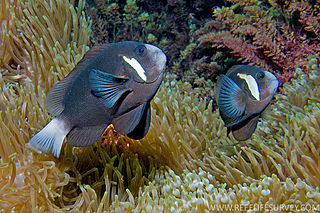
Amphiprion mccullochi, also known as whitesnout anemonefish or McCulloch's anemonefish, is a species of anemonefish found in subtropical waters at Lord Howe Island and Norfolk Island.. It was named for Allan McCulloch, a former Curator of Fishes at the Australian Museum, Sydney. Like all anemonefishes it forms a symbiotic mutualism with sea anemones and is unaffected by the stinging tentacles of the host anemone. It is a sequential hermaphrodite with a strict sized based dominance hierarchy: the female is largest, the breeding male is second largest, and the male non-breeders get progressively smaller as the hierarchy descends. They exhibit protandry, meaning the breeding male will change to female if the sole breeding female dies, with the largest non-breeder becomes the breeding male.
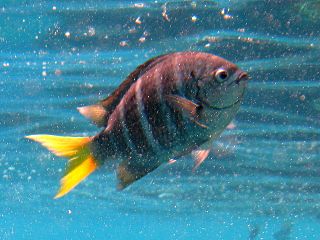
The yellowtail sergeant is a species of damselfish in the family Pomacentridae. They are found in the Indo-Pacific. It can grow up to a maximum length of 17 centimetres (6.7 in).

The fusilier damselfish is a species of damselfish in the family Pomacentridae. It found in the Indo-Pacific. They are found in the aquarium hobby. Adults can grow up to a maximum length of up to 10.5 centimetres (4.1 in). It is the only species in the monotypic genus, Lepidozygus which sits in its own subfamily, the Lepidozyginae.
Neoglyphidodon carlsoni is a species of damselfish in the family Pomacentridae. It is found in the western and central Pacific Ocean. Adults can grow up to a maximum length of 10 centimetres (3.9 in) This fish is omnivourous. Occasionally, they are found in the aquarium trade.

Amphiprion chagosensis, the Chagos anemonefish, is a marine fish belonging to the family Pomacentridae, the clownfishes and damselfishes. It is named for the Chagos Archipelago in the Indian Ocean and it is endemic to the archipelago. The original specimens were collected at Diego Garcia Atoll, Chagos Archipelago.
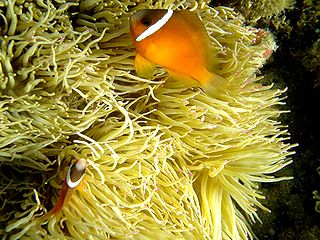
Amphiprion barberi, is a species of anemonefish that is found in the western Pacific Ocean. It was previously considered a geographic color variation of other anemonefish, initially Amphiprion rubrocinctus from 1972 and then Amphiprion melanopus from 1980 however further study and DNA sequencing resulted in A. barberi being described as a new species in 2008. Like all anemonefishes it forms a symbiotic mutualism with sea anemones and is unaffected by the stinging tentacles of the host anemone. It is a sequential hermaphrodite with a strict sized based dominance hierarchy: the female is largest, the breeding male is second largest, and the male non-breeders get progressively smaller as the hierarchy descends. They exhibit protandry, meaning the breeding male will change to female if the sole breeding female dies, with the largest non-breeder becomes the breeding male. The fish's natural diet includes zooplankton.

Dascyllus strasburgi, Strasburg's dascyllus, is a species of ray-finned fish from the family Pomacentridae, the clownfishes and damselfishes. It is endemic to the Marquesas Islands where they are found among coral and rocky reefs. and feed on zooplankton. The specific name honours Donald W. Strasburg of the University of Hawaii, a fish ecologist and collector of the type specimen.

Lepotrema acanthochromidis is a species of lepocreadiid digenean parasitic in the intestine of marine fish. It was described in 2018.

Lepotrema amansis is a species of lepocreadiid digenean parasitic in the intestine of marine fish. It was described in 2018.



















